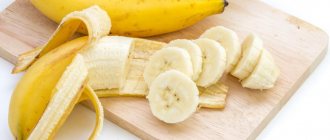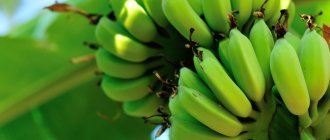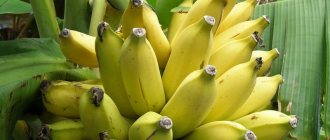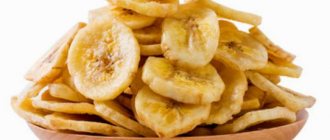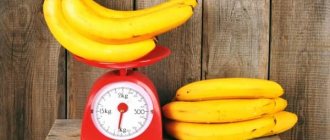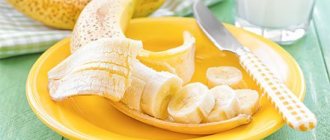As a rule, bananas are sold in bunches in stores. Rarely would it occur to anyone to buy these delicious tropical fruits individually. How to find out how much 1 banana weighs, and why is this actually necessary? The reasons can be different: from simple curiosity to very important and necessary actions.
For example, you are preparing some dish, the recipe of which includes a certain amount of banana pulp, or you are on a diet and carefully monitor the calorie count. By the way, for every gram of banana pulp there are only 0.89 kcal, which allows you to include these fruits in your diet for the purpose of losing weight.
Why know how much a banana weighs?
Culinary recipes amaze with their variety and value for proper nutrition. Many modern collections have a whole section of dishes that include banana. The list of ingredients, in addition to the name, contains the volume of necessary products, calculated in grams. There is a similar index in homemade cosmetics using exotic fruits.
Reference! The weight of dessert bananas exported to different countries ranges from 80 to 300 grams.
Many people mistakenly take the total weight of a banana as a basis, without thinking that without the peel, the mass of the pulp is significantly reduced. As a result of such an incident, the proportionality of the ingredients in the prepared dish is disrupted, which affects the taste of the dessert or salad. But the effect of the mask is not so effective due to the insufficient amount of vitamins or fruit acids in the cosmetic mixture.
Another compelling argument in favor of having knowledge about the mass of a banana lies in dietary nutrition. With a strict low-calorie diet, it is important to give the body the minimum that ensures the normal functioning of organs and systems. An excess will lead to inhibition of the weight loss process. Strict adherence to the recipe in combination with physical activity allows you to achieve your goal in a short time.
Why do you need to know the weight?
The mass of a banana is interesting from a practical point of view, and for different areas of life at once:
- Health - “mono” or complex fruit diets imply calculating the calorie content of each product, which is impossible without knowing the exact weight.
- Cooking - preparing desserts (mousses, salads or pastries) requires adherence to an exact recipe, which indicates the mass of each ingredient, and not its individual quantity.
- Baby food - when introducing complementary foods, young mothers are interested in the exact weight of the ingredients so that the prepared puree or porridge meets the baby’s needs.
- Beauty - skin care masks are made from banana pulp; the preparation of some of them requires the use of an exact amount.
Knowing how much one banana weighs is interesting from the point of view of expanding one’s horizons, because the fruits sold are presented in the same form as when they were cut - in bunches.
Weight of 1 banana
All bananas that can only be seen on store shelves should be conditionally divided according to parameters into three categories:
• small – length varies from 9 to 12 cm;
• medium – diameter 3-4 cm, length – 16-20 cm;
• large – length 25-30 cm with a diameter of 4-5 cm.
If the household has table scales, then all ingredients are simply weighed before adding. If this device is not available, you should not despair; you can determine the approximate weight of the fetus visually. To simplify calculations, the average options are always taken as a basis, and so is the case with bananas. The average exotic weighs 146-149 grams. This figure is rounded to 150 grams, and it is rational to use it to determine the weight of the pulp and peel separately.
Reference! All recommendations for determining the weight of peeled and peeled bananas are made taking into account standard products that are imported under license. There are low-quality fruits on the markets, many of which do not belong to dessert varieties. Their parameters may differ, as well as taste.
Why do you need to know the weight?
Due to the fact that bananas grow in clusters on palm trees, they are also sold in clusters. Buyers usually purchase a bunch or two, so they only know the total weight of the entire bunch. For this reason, the weight of one banana requires certain calculations, for which you need to remember their total weight, and then divide it by the number of bananas. Sometimes this is quite problematic, which is often due to the lack of a receipt from the store.
Knowing the exact weight of one banana is often required for fruit salad and mousse recipes, where the quantity of each ingredient must be measured as accurately as possible. In addition, when following various diets, it is necessary to carefully calculate the calories consumed, and in order not to weigh the fruits every time, it is enough to know their average weight and energy value.
Calorie content
If the pulp of a medium-sized banana weighs 100 grams, then it becomes easier to determine its calorie content. The indicator is 96 kcal, of which 1.5 g is allocated to proteins, 0.5 g to fats, 21 g to carbohydrates .
Reference! 100 grams of pulp contains many substances beneficial to the body: manganese (0.27 mg); vitamins K, C, B, E; zinc (0.15 mg); iron (0.6 mg); fluoride (2.2 mcg); selenium (1 mcg).
Calorie content can be determined in a similar way for large and small fruits. But first you need to calculate how many medium-sized bananas are in 1 kg. Dividing 1000 g by 150 g, we get 6.6666. With rounding, we can say that a kilogram consists of six to seven exotic medium-sized fruits. If 3-4 pieces are purchased per 1 kg, then the size of the bananas is considered large. Conversely, more than 7 pieces in 1 kg means that the fruit belongs to small varieties, and accordingly their weight will be less than 150 grams.
Regular banana
The average fruit is 20 cm long and weighs about 200 grams with the peel. The skin of a ripe banana weighs approximately 80 grams, which is 40% of the total weight of the fruit. In this regard, it is generally accepted that the average weight of one banana without skin is 120 grams.
However, if the fruit is unripe, then its peel can weigh 100 grams, which is exactly half of the total weight.
Small bananas usually weigh no more than 100 grams. Such fruits are distinguished by thinner and lighter skin, the weight of which does not exceed 30% of the total weight. Thus, a peeled mini banana weighs on average 70 grams, and the weight of its skin varies from 25 to 35 grams.
Banana weight without peel
If someone still thinks that the weight of a banana with and without peel is not significantly different, then it is worth familiarizing yourself with the statistical indicators. They indicate that the weight of the peel is approximately 40% of the total weight of the fruit. This means that, without taking this fact into account, you can make a mistake with the proportion of banana in the recipe by almost half.
Reference! The weight of an average banana is 150 grams. Accordingly, a banana peel weighs 56 grams (for ease of calculation, the figure is rounded to 50 g).
With peel
Most bananas that go on sale tend to be 18–20 cm long and are considered medium in size. While the length of small specimens is only 10 cm, large ones sometimes reach 30 cm.
Therefore, before visually determining the weight of the fetus, you should measure it with a ruler. If the length of the banana is more than 25 cm, then most likely the weight is 1 piece. will vary from 245 to 260 grams.
In this regard, it is generally accepted that the average weight of a large fruit with peel is approximately 250 grams.
How much pulp is in 1 kg of bananas?
Considering the weight of an average banana, you can calculate the mass of pulp from purchased 1 kg of fruit. Subtracting 40% for the peel, you get about 600 grams of a nutritious product. This indicator should be taken into account when drawing up a dietary menu or preparing culinary dishes.
Reference! One fruit of average pulp contains about 100 grams.
Having information about how much a banana weighs in its peeled form and with its peel, you can more accurately control the caloric content of your diet and calculate the amount of consumed vitamins and beneficial microelements contained in the pulp of the fruit.
Without peel
However, the weight of a banana with peel varies quite significantly from the weight of the peeled fruit. The banana peel is quite heavy and sometimes takes up more than 60% of the weight of the entire fruit. Because of this, the average weight of a large banana without the peel is 166 grams. But only large-fruited varieties have such a heavy peel; the skin of small and medium-sized varieties is much lighter and its weight on average is 40% of the total weight. In addition, the weight of the peel of a large banana depends on the degree of ripeness, and therefore it is generally accepted that the peel of a ripened banana takes up 55% of the weight, and that of a green banana - 60%.
How many vitamins are in a banana?
Banana pulp contains vitamins necessary for the normal functioning of the human body:
- vitamin C is a strong antioxidant that helps slow down the aging process of the skin and increase the body's resistance to various infectious diseases;
- B vitamins smooth out PMS symptoms and have a beneficial effect on the nervous system;
- Vitamin E prolongs the active activity of skin cells - it becomes elastic, firm and smooth;
- carotene will protect the body from cancer and cardiovascular diseases, and prevent premature aging of the body.
100 g of banana contains:
| Vitamins | Content in mg |
| 0,015 |
| 0,04-0,5 |
| 0,05-0,07 |
| 0,5-1 |
| 0,2 |
| 18 |
| 5,6-36 |
| 0,3 |
Composition and calorie content of banana
1 piece without peel contains the following amount of useful substances:
- proteins – 1.1-1.5 grams;
- fats – 0.3-0.5 grams;
- carbohydrates – 21-23 grams.
Banana pulp also contains vitamins and fiber. Moreover, the fruit contains useful substances that, when consumed regularly, have a positive effect on the human body and guarantee the prevention of depression.
To date, it has also been established that bananas contain vitamins A, B, C, potassium and magnesium. These vitamins and macroelements are considered the most beneficial.
Scientists note that the most useful are ripe bananas, the peel of which may have dark spots. It is advisable to choose these fruits in order to highlight the maximum possible benefits of the fruit.
As already mentioned, the calorie content of fresh bananas is determined by the variety and degree of ripeness. Usually, stores sell dessert varieties of bananas, which are small in size and average weight up to 200 grams. Large Platano bananas may not taste sweet enough, but they are more caloric and high in starch.
Ripe dessert bananas with very sweet pulp and a pleasant aroma have the lowest calorie content.
The calorie content of 1 banana without peel will vary. The pulp of an unripe fruit contains 120 calories, a ripe one - 90.
Does banana have starch?
Bananas always contain starch, but their proportion will vary. Unripe green bananas are usually rich in insoluble, resistant starch. This substance is not digested in the human small intestine, as fermentation occurs in the large intestine. For this reason, unripe fruits can lead to increased gas formation and turbulence in the stomach.
In ripe bananas, starch turns into sugar, so the fruits are especially sweet compared to green ones. At the same time, ripe bananas are easier to digest and assimilate.
When not to eat bananas
Regardless of how many calories are in a particular type of banana, in some cases you should not eat it at all:
- It is a sweet fruit and contains a large amount of sugar, so it should not be consumed by people suffering from diabetes.
- Overweight people are advised to exclude this product from their diet.
- Stale, poor quality and spoiled fruits can harm the liver.
- Bananas take a long time to digest, so you can eat them in small quantities.
- They are contraindicated for people with varicose veins and thrombophlebitis.
- The fruit thickens the blood, increasing the risk of thrombosis.
A banana does not contain many calories, so why do many people gain weight and gain weight by eating such a dietary fruit? It's all about the carbohydrates. When planning a diet, you need to take into account the carbohydrate base of the banana and adjust the rest of the diet so that the balance of proteins - fats - carbohydrates is not disturbed.
If you devote the bulk of your diet to banana dishes, then the rest of your diet should consist mainly of protein.
In this case, the fat component of the menu is given third place. For the diet to be effective, you need to organize your meals in accordance with your daily calorie intake, and also calculate how much protein, fat and carbohydrates should be on your plate every day.
THESE ARTICLES WILL HELP YOU LOSE WEIGHT
Is there starch in banana?
Depending on the state of banana ripeness, the proportion of starch in it is different:
- unripe, green bananas are rich in insoluble, resistant starch - this substance is not digested in the small intestine of a person, but undergoes a fermentation process in the large intestine, causing increased gas formation and rumbling in the stomach;
- In ripe bananas, starch is converted into sugar, which is why ripe bananas are sweeter than green ones and are easier for the digestion process.
There are people who much prefer the bright herbal taste of unripe bananas - perhaps knowledge of the significant starch content in such fruits will help them create a more rational menu.
How to eat bananas when losing weight?
Scientists have proven that regular consumption of bananas helps with weight loss. This is because this product has high nutritional value, it is rich in a variety of antioxidants and microelements. Thanks to this, banana is considered a healthy and nutritious food.
Despite the fact that banana has a relatively low calorie content, it is excellent as a post-workout meal for gaining muscle mass. Banana has a fairly low glycemic index and contains many trace minerals.
Starch, fiber and pectins quickly satisfy hunger and cause a long-lasting feeling of fullness. All these components make banana a useful dietary product.
Calorie content of different types of bananas
Many people are accustomed to seeing regular bananas on supermarket shelves, so few people think about the existence of other varieties. In fact, it is advisable to consider the variety of banana varieties.
Mini banana is also called "baby". This fruit is sold in large bunches. Mini bananas taste and aroma like regular fruit. The main difference is the lower calorie content. One piece can contain up to 80-90 kcal.
Banana Platano is a rare variety of green banana. The main difference is the minimal amount of sugar. In addition, the fruit has a slightly sour taste. The energy value of the Platano banana is 60 kcal per piece.
Both varieties, mini banana and Platano, are more common abroad.

